Creating a lush garden under mature trees might feel like an impossible task. With dense canopies blocking sunlight and thirsty roots soaking up water, it’s no wonder most plants struggle in these shady spaces. But don’t give up just yet—there are beautiful, hardy plants that love the shade and can handle the tricky environment beneath trees.
Whether you’re looking to fill in gaps with ground cover or introduce elegant foliage and seasonal color, this list of 17 shade-tolerant plants is your ultimate under-tree solution. These plants don’t just survive—they thrive, bringing life to those darker corners of your yard. Let’s dig into your options and create a woodland oasis right outside your door.
Things to Consider Before Planting Under Trees
Before you begin planting, it’s essential to understand what makes under-tree conditions so tough. Mature trees often have extensive root systems that aggressively compete for nutrients and water. Soil in these areas can be dry, compacted, and low in organic matter. Enhancing the soil with compost or mulch can improve conditions and give your plants a better chance to succeed.
Lighting under trees is another major challenge. While some areas receive dappled sunlight through the branches, others are in deep shade all day. Knowing whether your tree casts full, partial, or filtered shade will help you choose the best plants for that specific environment. Not all shade is created equal, so observe how light moves through your yard before planting.
Lastly, maintenance is key. Newly planted shade lovers may need consistent watering until established. A drip system or frequent deep watering can help. Avoid digging too deeply around tree roots to prevent damage, and stick to shallow-rooted plants where possible. With a thoughtful approach, your under-tree garden can be as vibrant as your sun-filled beds.
17 Shade-Tolerant Plants That Thrive Under Trees
1. Hosta (Hosta spp.)
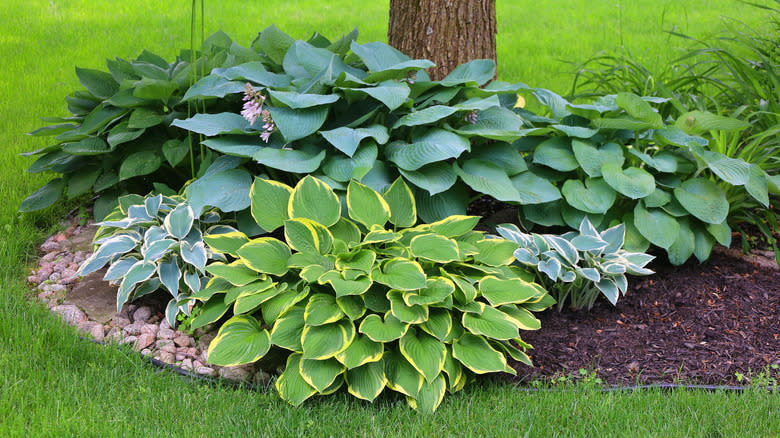
Hostas are the ultimate go-to for shade gardens, especially beneath trees. Their large, often variegated leaves add bold texture and come in a variety of greens, blues, and yellows. While they’re known for their foliage, many varieties also produce elegant spikes of lavender or white flowers in summer.
These plants thrive in the filtered light under tree canopies and can tolerate root competition better than most. Hostas prefer rich, moist soil but can adapt to drier conditions once established. They form tidy mounds that help define borders or fill large bare spots under trees beautifully.
One downside is their vulnerability to slugs and deer, so you may need to take precautions. Mulching around the base helps retain moisture and deter pests. With hundreds of varieties available, you can mix and match for color and texture to create a layered, dynamic under-tree bed.
2. Ferns

Ferns bring a lush, woodland feel to your garden and love shady, humid conditions. Popular varieties like Lady Fern, Japanese Painted Fern, and Ostrich Fern all have delicate, feathery fronds that add movement and soft structure beneath towering trees. Their texture pairs beautifully with broader-leafed plants like hostas.
These plants are especially suited to areas with consistent moisture, making them perfect for shaded zones that stay damp. Even in drier shade, some ferns (like the Japanese Painted Fern) can adapt with a little extra care during dry spells. Their low-maintenance nature makes them ideal for busy gardeners or low-traffic areas.
Best of all, ferns are virtually pest-free and deer-resistant. They spread slowly, creating graceful, natural-looking colonies over time. Plant them as a backdrop or a soft, elegant filler among bolder foliage for a tranquil under-tree display.
3. Coral Bells (Heuchera spp.)
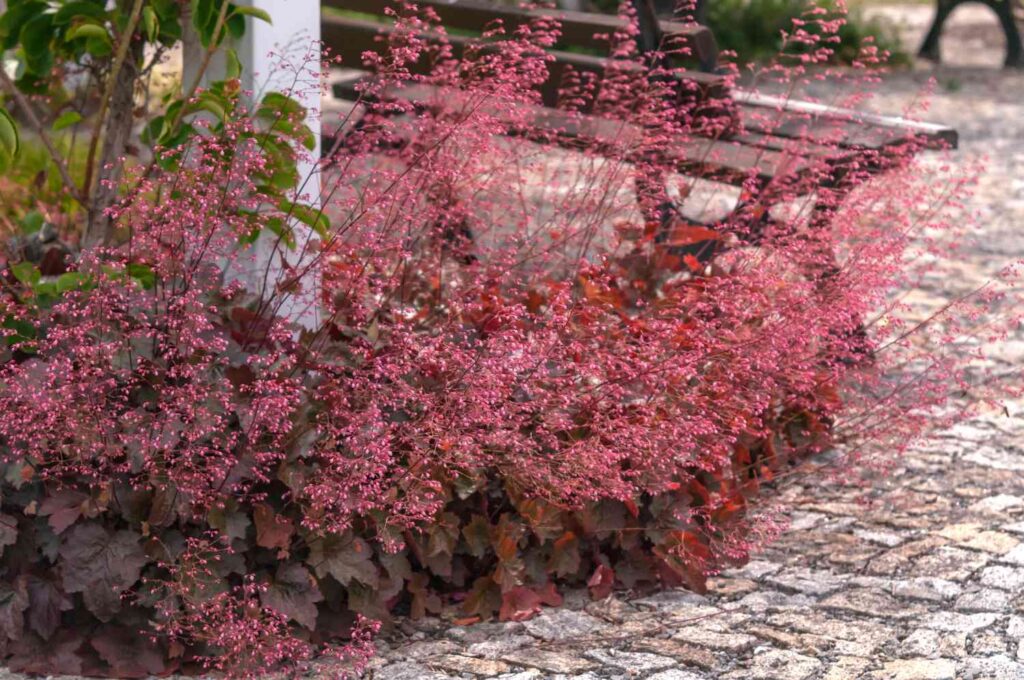
Coral Bells offer a stunning pop of color beneath trees, thanks to their vibrant foliage in shades of purple, bronze, lime green, and rose. Their small bell-shaped flowers bloom on tall stalks in spring or early summer, attracting hummingbirds and adding vertical interest.
What makes Heuchera a star under trees is its ability to thrive in partial to full shade, along with its drought-tolerant nature. Once established, Coral Bells don’t mind dry soil and can handle root competition well. Their compact mounds work wonderfully along paths, borders, or in mass plantings for a swath of color.
They pair nicely with ferns, hostas, or ornamental grasses, adding color without overwhelming the space. While generally low-maintenance, occasional pruning of spent flower stalks and old leaves will keep them looking their best throughout the season.
4. Lungwort (Pulmonaria)

Lungwort may not have the prettiest name, but it’s a gem for shady spots under trees. It features spotted or silvery foliage and charming clusters of pink, blue, or purple flowers that often bloom in early spring. The foliage remains attractive all season long, even after the flowers fade.
This plant thrives in moist, well-drained soil and tolerates even deep shade. It’s especially useful under deciduous trees where early spring light helps it bloom before the canopy fills in. Once mature, Lungwort forms dense clumps that resist weeds and create a full, textured look.
Lungwort is also deer-resistant and attracts early pollinators. It spreads slowly, so it’s perfect for filling small gaps and creating borders without becoming invasive. Mulch around the base to help retain moisture and keep the foliage clean.
5. Astilbe

Astilbe is a shade garden favorite thanks to its fern-like foliage and feathery blooms in white, pink, red, and lavender. The tall flower plumes appear in early to mid-summer, adding vertical interest and softness to otherwise dark areas beneath trees.
Astilbe prefers moist, rich soil and partial to full shade. It’s an excellent choice for spots under trees where the soil retains some moisture—perfect if you have a natural dip or slightly lower elevation in your yard. Regular watering during dry periods is essential to prevent crispy leaves.
Despite its delicate appearance, Astilbe is fairly tough and will return year after year with little effort. Deadheading the flowers isn’t necessary unless you want to tidy up its look. Use in groups to create colorful waves beneath trees or pair with hostas and ferns for a soft, layered effect.
6. Solomon’s Seal (Polygonatum)
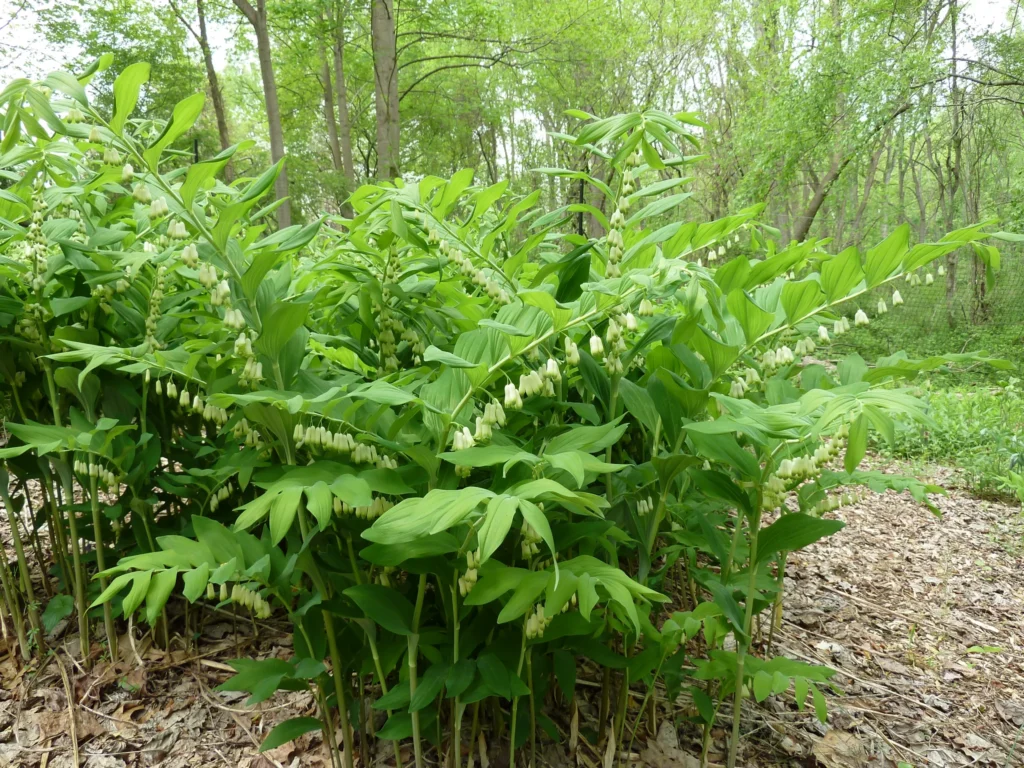
Solomon’s Seal adds graceful elegance beneath trees with its arching stems and dangling, bell-shaped white flowers. The leaves are arranged alternately along the stem and turn a buttery yellow in fall, extending the plant’s interest into late seasons. It brings a natural woodland charm to shaded areas.
This plant performs well in partial to full shade and is especially tolerant of dry soil once established, making it ideal for the root-filled space under trees. It spreads slowly through rhizomes, forming colonies over time without becoming invasive, and it’s also deer-resistant—perfect for more rural or wooded areas.
Maintenance is easy—just remove old foliage in late fall or early spring. Solomon’s Seal looks stunning in mass plantings or along shaded pathways under trees. Pair it with ferns, bleeding hearts, or foamflowers for a textural contrast and naturalistic vibe.
7. Bleeding Heart (Dicentra spectabilis)
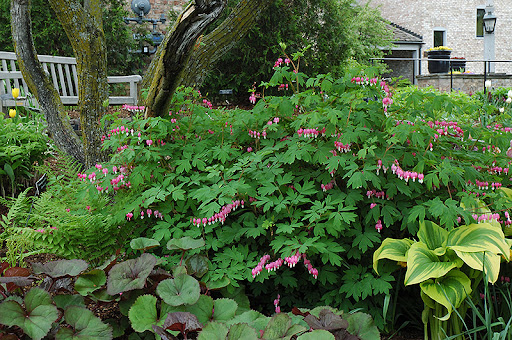
Bleeding Heart is a timeless favorite known for its romantic, heart-shaped pink or white flowers that dangle from arching stems. It blooms in spring and early summer, making it one of the first plants to light up a shaded under-tree space with color and charm.
This perennial prefers partial to full shade and thrives in moist, well-drained soil. It’s an ideal pick for areas under deciduous trees, where it receives bright light in early spring before the canopy fills out. Once summer arrives, it naturally goes dormant, allowing other plants to take the stage.
Though delicate-looking, Bleeding Heart is surprisingly tough. Mulch can help retain moisture and keep the roots cool, especially in drier conditions. Pair it with late-blooming or evergreen plants to maintain visual interest once it goes dormant in mid-summer.
8. Japanese Forest Grass (Hakonechloa macra)

Japanese Forest Grass brings a soft, flowing texture to shaded gardens, especially beneath trees. With its arching, golden or lime green blades, it creates a bright, cascading effect that stands out against darker foliage. Its gentle, swaying motion adds a sense of serenity and movement.
Thriving in partial to full shade, this ornamental grass prefers moist, well-drained soil and tolerates root competition fairly well. It grows slowly but forms tidy clumps that look great along borders or spilling over stone edging near tree trunks.
Unlike most grasses, Japanese Forest Grass isn’t aggressive or invasive. It requires minimal upkeep—just trim it back in early spring before new growth emerges. Pair it with Coral Bells, ferns, or hostas for a rich tapestry of textures and tones in your under-tree planting.
9. Brunnera (Brunnera macrophylla)
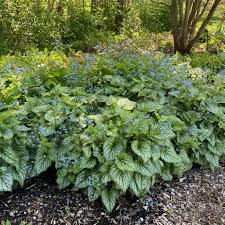
Brunnera, also known as Siberian Bugloss, is prized for its large, heart-shaped leaves—often variegated with silver—and its dainty, forget-me-not-like blue flowers that bloom in spring. It’s a wonderful under-tree plant that brightens shady areas with both foliage and blooms.
This plant tolerates deep shade and dry conditions better than many, making it perfect for tricky spots beneath dense tree canopies. It thrives in humus-rich soil but can adapt with added mulch and occasional watering during dry spells.
Brunnera is low-maintenance and not typically bothered by pests or deer. It pairs beautifully with spring-blooming bulbs and makes an excellent backdrop for smaller ground covers or early bloomers like Lungwort and Tiarella. Let it naturalize in clusters for maximum visual impact.
10. Epimedium (Barrenwort)
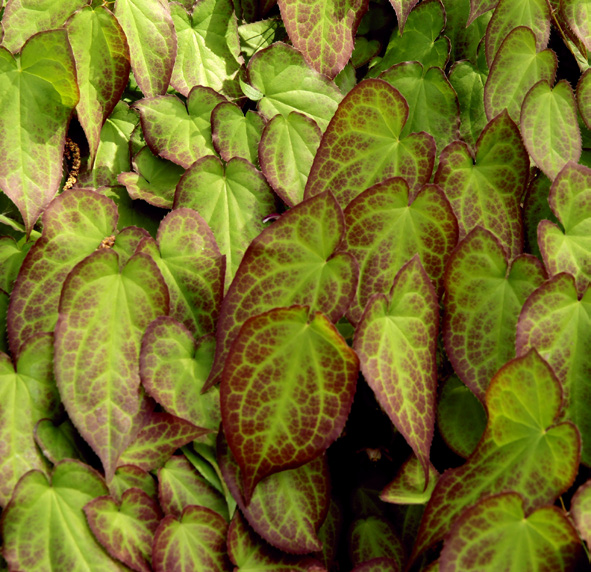
Epimedium, also called Barrenwort or Bishop’s Hat, is a tough, adaptable ground cover that performs beautifully in dry shade—right where many plants fail. Its heart-shaped leaves often emerge bronze or red-tinted in spring and mature to green, with sprays of delicate flowers in white, pink, or yellow.
This plant thrives under trees thanks to its deep drought tolerance and ability to spread slowly by rhizomes. It can handle root competition and still put on a graceful, airy show. Plus, it’s deer- and rabbit-resistant, adding to its appeal for shade gardens.
Maintenance is minimal—just cut back old foliage in early spring before new leaves emerge. Use Epimedium to cover difficult bare patches under trees or combine it with woodland plants like ferns and Brunnera for a soft, layered look.
11. Toad Lily (Tricyrtis)
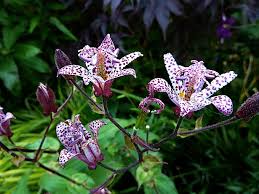
Toad Lily is a unique shade-lover that brings late-season interest to your garden. Its exotic-looking, orchid-like flowers appear in late summer to early fall and come in purple, blue, or white with spotted markings. These blooms thrive in filtered shade, adding unexpected color when most plants have faded.
Under trees, Toad Lily prefers moist, rich soil and performs best in areas protected from harsh afternoon sun. It stands out in shady corners where few other plants flower late in the season. The upright habit of the plant works well for small pockets between tree roots or shaded borders.
These plants are also fairly low-maintenance and deer-resistant. Mulching around the base helps retain soil moisture and keep roots cool. Group a few together to create a dazzling late-summer focal point in your under-tree planting scheme.
12. Sweet Woodruff (Galium odoratum)
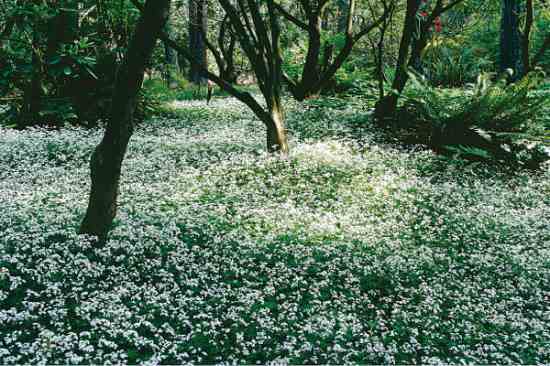
Sweet Woodruff is a low-growing, shade-loving ground cover that emits a pleasant, hay-like fragrance when crushed or dried. Its whorled green leaves form a dense mat beneath trees, and it produces small white star-shaped flowers in spring that add brightness to shady areas.
Ideal for full or partial shade, this plant thrives in moist, well-drained soil but can tolerate drier conditions once established. It spreads easily but isn’t overly aggressive, making it perfect for naturalizing under trees and suppressing weeds.
Sweet Woodruff is often used under deciduous trees because it grows actively in spring before the canopy fully shades the ground. It combines beautifully with spring bulbs and other woodland perennials like Lungwort and Brunnera.
13. Bugleweed (Ajuga reptans)
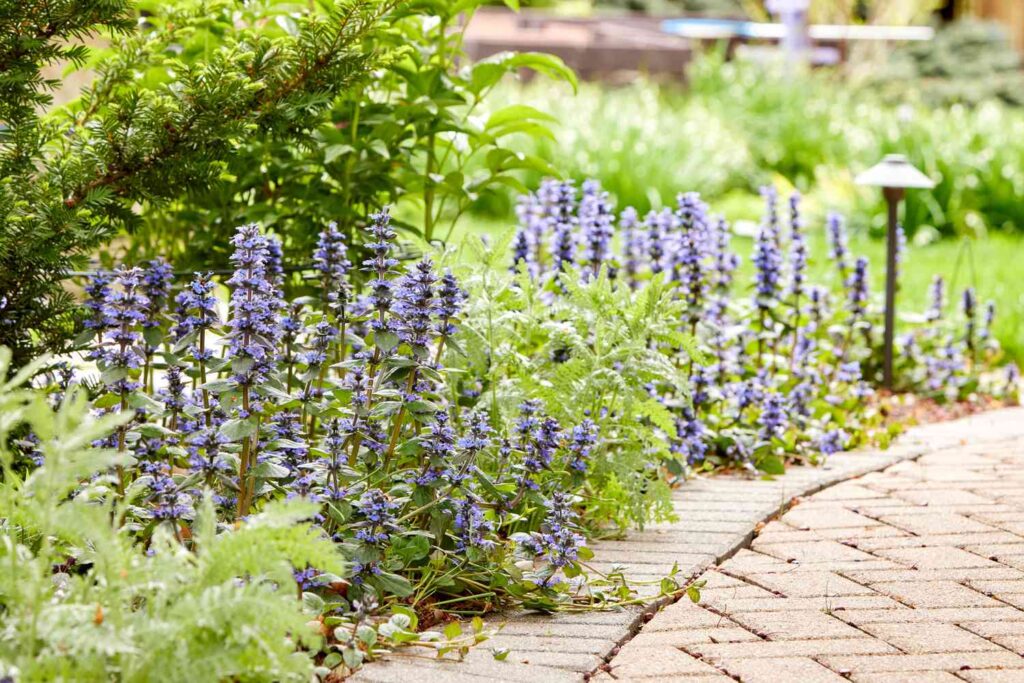
Bugleweed is a fast-spreading groundcover that offers glossy leaves and vibrant flower spikes in blue, purple, pink, or white. The foliage comes in a range of colors, including green, bronze, and burgundy, providing year-round interest even when it’s not in bloom.
This low-growing plant thrives in full to partial shade and adapts well to the dry, compacted soil commonly found under trees. Its ability to quickly form dense mats helps control erosion and suppress weeds, making it perfect for hard-to-plant spots with heavy root competition.
Ajuga is low-maintenance and deer-resistant but can be invasive in ideal conditions, so consider using edging or root barriers if you want to control its spread. It’s especially attractive when planted in masses or used to line shady garden paths beneath tree cover.
14. Lamium (Deadnettle)
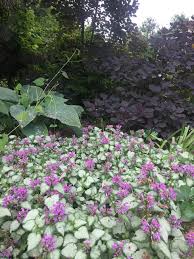
Lamium is a beautiful and versatile groundcover prized for its silver-variegated foliage and charming flowers in white, pink, or purple. It provides a striking contrast in darker garden areas and blooms throughout spring and into summer, making it a standout under trees.
This plant thrives in full to partial shade and tolerates dry conditions once established. It grows quickly and spreads without becoming overly aggressive, making it a great filler for under-tree planting beds, especially around tree trunks where other plants struggle.
Lamium works well with ferns, Coral Bells, or Brunnera, and it can even be used in hanging baskets for shady porches near tree-lined yards. Trim it occasionally to maintain shape and prevent crowding. It’s both deer-resistant and pollinator-friendly.
15. Foamflower (Tiarella)
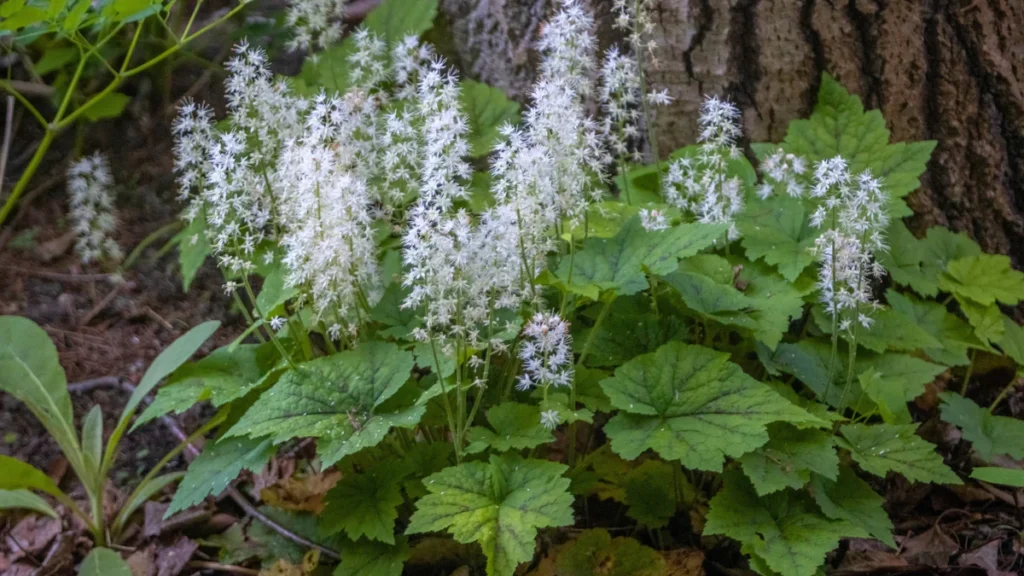
Foamflower adds a woodland charm to shady areas with its maple-shaped leaves and foamy white or pale pink blooms that rise above the foliage in spring. Some varieties feature leaves with dark veining or autumn color changes, providing multi-season interest.
This plant prefers moist, well-drained soil and thrives in partial to full shade, making it a natural companion for other woodland species like ferns and Lungwort. It forms attractive clumps that slowly spread by runners, creating a soft groundcover effect.
Foamflower is an excellent choice for planting under deciduous trees, where it benefits from early spring sunlight. It’s low-maintenance, deer-resistant, and great for layering in front of taller perennials like Bleeding Heart or Hostas for a layered, cottage-style garden look.
16. Creeping Jenny (Lysimachia nummularia)

Creeping Jenny is a bright, eye-catching groundcover known for its trailing stems and chartreuse or golden foliage. It adds a splash of color to dark, shaded areas and can cascade over garden edges, rocks, or containers beautifully.
This plant does well in partial to full shade and tolerates a range of soil conditions, including moist or even soggy areas, which can be found near trees with dense canopies. It spreads rapidly, so it’s best used in areas where you want fast coverage or in contained spaces like raised beds.
While not the best fit for dry shade without supplemental watering, Creeping Jenny is perfect for bringing life to wetter, shaded zones. Pair it with upright plants like Japanese Forest Grass or Coral Bells to contrast its sprawling nature and vibrant foliage.
17. Wild Ginger (Asarum canadense)
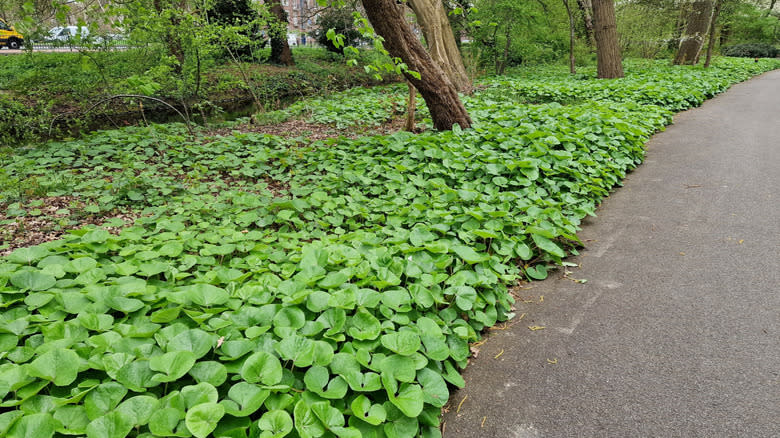
Wild Ginger is a native woodland groundcover that thrives in deep shade, making it one of the best choices for dense tree cover. Its glossy, heart-shaped leaves form a lush carpet, and though its flowers are hidden beneath the foliage, they add a whimsical surprise when discovered.
This plant loves rich, moist soil and adapts well to shade gardens with minimal fuss. It spreads by rhizomes, gradually filling in space beneath trees where lawn or other plants often fail. Wild Ginger is deer-resistant and typically free of pest issues.
It’s a great companion to other native plants and woodland species. Use it to create a natural-looking under-tree bed, and enjoy its elegant foliage throughout the growing season. Once established, it needs little maintenance and can help control erosion and weeds around tree bases.
Final Thoughts
Shady areas beneath trees don’t have to be a dead zone in your landscape. With the right plants, you can turn even the darkest corners of your garden into a lush, layered, and thriving ecosystem. From bold foliage to delicate blooms and rich groundcovers, these 17 shade-tolerant plants offer endless combinations for year-round beauty.
Start by assessing your light levels, soil conditions, and moisture availability, then choose a mix of plants that complement one another in color, texture, and height. Whether you want a vibrant groundcover carpet or a dreamy woodland vibe, there’s a plant (or five) here for you.
So don’t let that shady tree intimidate you—embrace it. With these tried-and-true plant selections, your garden can flourish from top to bottom.
